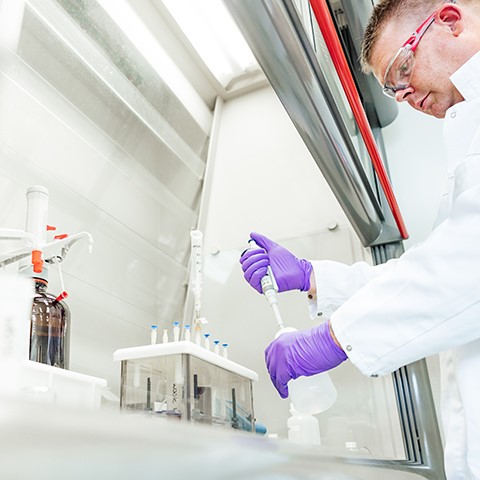Nuclear research facilities
The reactor and our nuclear research facilities
The Energy & Health Campus in Petten is home to a unique combination of nuclear installations. Over the past 60 years, the site has expanded and acquired international allure. With the knowledge developed in these Nuclear research facilities and the continuous production of medical isotopes, our services and products are literally lifesaving.
Numerous preparations are also being made for the future and a new research laboratory is being built called FIELD-LAB, where new nuclear medicines will be developed. The production of medical isotopes is being expanded and planning permission has been requested for the construction of the Nuclear Health Center by the Foundation Preparation Pallas-reactor. This foundation is also applying for planning permission for the PALLAS reactor, the successor of the HFR. We are building for the future.
More

The High Flux Reactor
The HFR is one of the few reactors in the world which can make nuclear medicines (medical isotopes). Every day, substances for nuclear medicines are produced for 30,000 patients. These patients are suffering from cancer or some other life-threatening disease. The reactor is also frequently used for research into safe and new nuclear energy, such as research into Thorium reactors. The HFR has been in operation since 1961. In the mid-2020s, the HFR will be replaced by the new PALLAS reactor, for which construction plans are currently being prepared.
Reactor
Of 30 days, this gives the reactor its high availability.
The High Flux Reactor is a 45 Megawatt-material test reactor.
Due to the High Flux, it is possible to look ahead in time, 10 times faster.
Patients are helped every day with medical isotopes from the reactor.
Hot Cell Laboratories
Hot Cell Laboratories (HCL) are used to study or process radioactive materials. If a product is irradiated for research in the HFR, it becomes radioactive. Due to the high radiation levels, you can then no longer handle it with bare hands. It is therefore further examined or processed in a so-called hot cell. Our employees work safely using telemanipulators behind lead glass.

NRG is a global leader in the production of medical isotopes
Molybdenum Production Facility
In the Molybdenum Production Facility (MPF), molybdenum-99 is extracted from irradiated targets. This is a physical-chemical proces, developed and performed by Curium. A so called 'generator' is loaded with molybdenum-99, which is used in hospitals to 'draw off' technetium-99m. The molybdenum-99 decays with a half-life of around 66 hours into technetium-99m, which is then used to make scans (SPECT, Single Photon Emission Computed Tomography) of patients.
During the irradiation process in the reactor, a wide range of isotopes are formed, just like molybdenum-99. These isotopes go for further processing to the Molybdenum Production Facility (MPF), where pharmaceutical producer Curium extracts the molybdenum-99 from the targets using a chemical process. Curium places the molybdenum-99 in the generators, which are used in hospitals to draw technetium-99m from, that can be used for scans (SPECT, Single Photon Emission Computed Tomography). This is how 30.000 patients can be treated on a daily basis.

Jaap Goedkoop Laboratory
In the Jaap Goedkoop Laboratory (JGL), our staff studies the development of new nuclear medicines to treat patients. Solutions for radioactive waste are also sought in this laboratory. By carrying out extra irradiations of radioactive waste, we reduce the amount of waste in the long term. The life span of radioactive waste can be significantly shortened. The laboratory uses advanced instruments which can detect the changes in the properties of materials used for nuclear reactors, in order to assess the effects of ageing.
The JGL is named after Prof. Dr. J.A. Goedkoop, former scientific director of the Dutch Reactor Centre, and founder of the nuclear infrastructure in Petten, and in the Netherlands.

Facilities for analyses
NRG has essential Nuclear research facilities for NRG to comply with all laws and regulations associated with our special activities. For the safety of our employees and the environment, we continuously analyse samples from our business processes, such as measurements in the waste water, the basin water and the air. A team of highly trained analysts perform these analyses. They use many different analysis equipment in rooms that are especially suitable for measuring extremely low activities:
- A room adapted to get a low background radiation, so that we can measure up to very low activities. Our sensitive measuring equipment is located in this room.
- Measuring equipment to measure alpha, beta and gamma radiation.
- A Total Body Counter, for measuring potentially infected people.
- ICP-OES, Inductive Coupled Plasma - Optical Emission Spectrometry, for measuring a large number of elements.
- X-ray equipment for irradiating seeds, flower bulbs and for conducting experiments on material aging.
- Several fume hoods for pre-processing material.
With these Nuclear research facilities we ensure a safe working and living environment. In this way we can quickly adjust our business processes in case of minimal deviations. Would you like to know more about the analyses we perform?
Decontamination & Waste Treatment
Our Decontamination & Waste Treatment (DWT) is used for cleaning of radioactively contaminated materials. Often these are installation parts from the nuclear infrastructure in Petten, or from offshore oil and gas extraction. In these offshore installations, natural radioactivity accumulates which has come up from deep under the ground. We clean the contaminated materials. The radioactive waste is separated, collected, packed and transported to COVRA (Central Organisation for Radioactive Waste) in Borsele.
Waste Storage Facility
The Waste Storage Facility is mainly used for the temporary storage of radioactive waste before it goes to COVRA (the Central Organisation for Radioactive Waste) in Borsele. The facility also stores the historic waste from the 1960s. It emerged from research by the predecessors of the NRG organisation and was intended to remain here (safely) forever. This waste is now also transferred to COVRA. This operation will be completed in the coming years.

